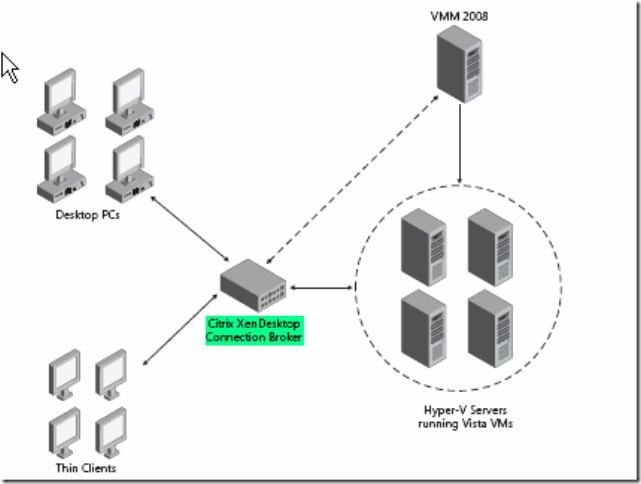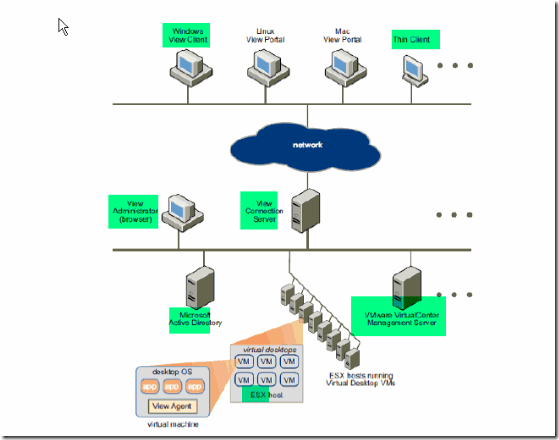微軟與VMWARE的桌面虛擬化對(duì)比
一、VDI作用簡要說明
對(duì)VDI更多的理解和作用還是請(qǐng)用GOOGLE吧。或是去微軟或VMWARE的官方站點(diǎn)。
1、通過 Virtual Desktop Infrastructure,企業(yè)可以使用虛擬化技術(shù)在數(shù)據(jù)中心以虛擬機(jī)形式托管桌面。
2、用戶可以使用遠(yuǎn)程顯示協(xié)議從 PC 或瘦客戶端進(jìn)行訪問。
二、理解微軟的桌面虛擬化解決方案
微軟的桌面虛擬化主要有兩個(gè)方面:
1、Client-hosted類型的:以Virtual pc 2007為基礎(chǔ)。輔助于MED-V(Microsoft Enterprise Desktop Virtualization)。
而MED-V目前還在初期階段,據(jù)我所知的版本是V1.0。
A、MED-V environment(包含的組件,就不譯成中文了,很簡單的):
Host The end user’s physical computer, typically a desktop or laptop computer. It’s
also called an endpoint computer.
MED-V Client Software that runs on the host that can download and run Virtual PC
images seamlessly on the host, according to MED-V usage policies.
MED-V Image Repository An IIS Web server that stores and distributes virtual images
to endpoints.
MED-V Management Server A MED-V server that authenticates, provisions, and
controls all users of the system. Client-server communication is based on HTTP or
HTTPS.
MED-V Server The server that holds the main image repository and is the
management server.
MED-V Package A mechanism for installing Virtual PC, the MED-V client, and
optionally a virtual image on a host.
Workspace The Virtual PC image that the MED-V client runs on the host. It’s also
called a virtual machine or guest.
B、對(duì)Virtual PC 2007增強(qiáng)的支持:
Virtual images repository and delivery 虛擬鏡像存儲(chǔ)和分發(fā) Simplifi es the process of creating, testing,
delivering, and updating virtual images。
Centralized management and monitoring 集中的管理和監(jiān)視 Manages the life cycle of virtual images,
provisions virtual images to authenticated users according to Microsoft Active Directory users and groups, and aggregates client events for monitoring and reporting purposes。
User policy and data transfer control 用戶策略和數(shù)據(jù)傳輸 An endpoint agent enforces usage policies and data transfer permissions on the virtual machine。
Seamless end-user experience 無縫的最終用戶體驗(yàn) The user remains unaware of the virtualization
running in the background and keeps one desktop environment。
2、Server-Based類型的:以Hyperv-V為基礎(chǔ),使用VMM2008作為管理中心。

此圖就是典型的MS的VDI虛擬桌面基礎(chǔ)架構(gòu)解決方案的拓樸。可以和接下來VMWARE作一些對(duì)比。但目前應(yīng)用較少,老方還沒有發(fā)現(xiàn)在企業(yè)中的成功應(yīng)用。如果有此經(jīng)驗(yàn)者,請(qǐng)交流下。老方也會(huì)在較有精力時(shí)為大家奉上使用體驗(yàn)的系列文章,敬請(qǐng)觀注。
三、理解VMWARE的桌面虛擬化解決方案
VMWARE的桌面虛擬化也主要有兩個(gè)方面:
1、Client-hosted類型的:VMware Workstation 系列版本,實(shí)際上,老方如果不是怕VMWARE不答應(yīng)也想把VMware Server給歸置到此類。不過嚴(yán)格來說應(yīng)屬于服務(wù)器虛擬化范疇啦。
此軟件,相信大多數(shù)朋友都有使用過的經(jīng)歷。此處免去介紹。
2、VMware VDI解決方案(VIEW 3.0)

VMWARE的VDI解決方案在企業(yè)中應(yīng)用較為廣泛:像在呼叫中心、集中訪問等。
通過上述的拓樸大家就可以清楚典型的VMWARE的VIEW解決方案:客戶端(連接客戶端)——VDM (連接服務(wù)器)——VC——ESX SERVER。當(dāng)然也可以去掉VC集中管理直接連接ESX。更直白的說就是VDM CLEINT +VDM CONNECT SERVER +VI3構(gòu)成了VMWARE的虛擬桌面解決方案。
桌面池、動(dòng)態(tài)池、靜態(tài)池、是否分配固定桌面均是通過VDM Connect server來進(jìn)行的。總之,它提供了豐富的管理功能以及兩種VDM類型(網(wǎng)關(guān)或僅代理型)。
以上,只是簡要說明了下,以使大家有個(gè)入門的了解。更詳細(xì)的功能或架構(gòu)還請(qǐng)參考官方文檔。老方誠意為大家多交流關(guān)于虛擬化方面的技術(shù)及解決方案,以使在交流中進(jìn)步。
【編輯推薦】
























